
Traversing Time and Culture in Thailand: Winter Programme with Mahidol University
06 Jan 2024 - 13 Jan 2024
Event Navigation

Article written by Ian Michael Yam
Through the efforts of the NUS Global Relations Office, 22 NUS students had the privilege of participating in the DCU Global Youth Camp hosted by Mahidol University at its Salaya and Kanchanaburi campuses from 6 to 13 January 2024. In particular, a few participants like myself received this opportunity through the emphasis that the College of Alice & Peter Tan (CAPT) places on global education.
The NUS contingent was led by Dr Toh Tai Chong from the CAPT. Dr Toh and other esteemed lecturers from Mahidol University and the University of Southern Queensland guided participants in engaging Sustainable Development Goals (SDGs) through four distinct themes: (1) Biology and Environment, (2) Cyber-security and AI, (3) Financial Literacy and Economic Growth and (4) Diversity and Inclusiveness. I had the chance to enrol in the Economic Growth module.
Sustainable Economy in Sapphaya
Students in the Economic Growth module began their trip by taking a 3-hour minibus ride northwards to Sapphaya, located in the Chai Nat province.
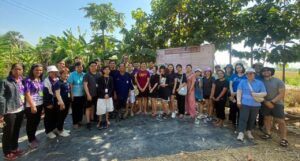
The team was welcomed by refreshing rural landscapes and the warm wais (greetings) of Sapphaya’s community leaders. We were honoured to have the local mayor introduce the Sapphaya community and the close collaboration between Sapphaya and Mahidol University, made possible by Assistant Professor Kaewta Muangasame whom we all affectionately referred to as ajahn (an honorific used for professors in Thailand).
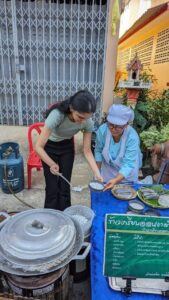
Participants were able to bond with the residents of the old town through learning the art of their trade: be it flipping Sapphaya-style pancakes, weaving keychains out of intricate Batik cloth, or knitting bracelets from hyacinth leaves. The eventful first day ended with lots of fon with the locals (no pun intended – it is actually a folk dance that everyone can join in!)
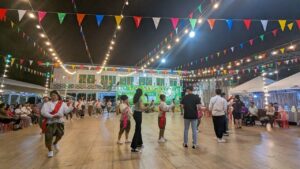
After a fun-filled day one, it was time to do ‘real work’ on day two. Everyone rose at the crack of dawn and headed down to the river — where fishermen explained the knowledge that had been passed through generations: catching techniques, or the intricate details which makes one arowana more prized than another.

Then we waded into the chest-deep water to visit the fishing nets (meanwhile, the more faint-hearted sailed by on small boats). Managing the day’s catch was not easy at all, amidst the small mackerel fish flying about, giving you the occasional ‘slap in the face’. After putting in sufficient effort, everyone was rewarded with breakfast: sitting on wooden benches by the river bed, eating rice and the fried aftermath of the day’s catch, appreciative of the hard work that the local fishermen put in to sustain their trade.
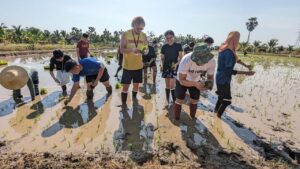
This was quickly succeeded by a journey to the rice fields. There, all of us lined up in an orderly fashion in the knee-deep wet soil and learnt how to plant rice seedlings the ‘traditional’ way. Interestingly, the farmers shared how despite the increasing adoption of technologies in rice farming, certain rice plantations were still preserved for these ‘traditional’ (and much more back-breaking) techniques, or dam na as it was called by the locals.

All these insightful activities culminated in a brainstorming session with Sapphaya’s local administration committees on how to promote sustainable tourism in the area. Community leaders shared the framework prescribed by the Tourism Authority of Thailand comprising 10 criteria – yet the one that stood out to us was “Culture & Sense of Place”. This is because apart from managing environmental impact, sustainability also depends on continuing the stories and values of the people of Sapphaya.
It was with a heavy heart that we bid farewell to the friends we made at Sapphaya!
Youth Voices
Participants from the different modules then reconvened at the Salaya campus for a day to exchange thoughtful reflections from the past few days. Our team from the Economic Growth module shared about the harmony that the Sapphaya community strives to build with the environment – it is this principle that guides many of their local tourism policies, including only opening the night market to group tours on certain weekends.
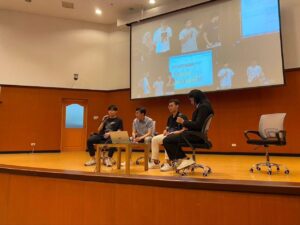
Our friends from Mahidol University also showed us around their beautiful campus, which included the Music College — a quaint wooden building surrounded by lush gardens, a boardwalk bordered by an expansive lake filled with koi fish, and the occasional monitor lizard looking for its lunch.

Everyone was then scrambled into different groups for the second half of the trip: learning journeys to Kanchanaburi province. Of the three programmes offered by Mahidol University, the visit to Sangkhlaburi (which promised a visit to the Thai-Myanmar border) stood out as especially intriguing.
Sangkhlaburi Sojourn
Sangkhlaburi is the Westernmost point in the Westernmost province in Thailand. This was immediately evident – one just had to roam around for a bit and notice that the language that the locals spoke here did not sound exactly like Thai. In fact, it was Mon language, spoken by the minority Mon ethnic group who originally hail from Myanmar. This explained the difference in architecture; the temples we visited, Wat Wang Wiwekaram and Wat Jom Nam (a temple almost fully submerged in the river) retained strong Burmese characteristics.
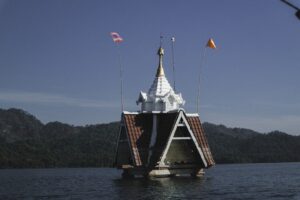
Our group had the chance to stop by the Three Pagodas Pass, a once often-used passageway now sealed off due to the ongoing civil war between the junta and ethnic rebels. Nonetheless, some of us made it a point to technically stand on Myanmar soil (marked by a sign), since the border post was located slightly within Myanmar territory.
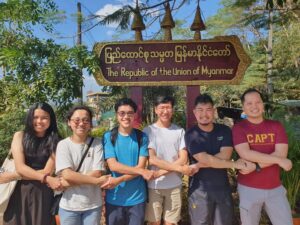
The Sangkhlaburi sojourn ended with a visit to the wooden Mon Bridge at dawn, where we presented alms to the monks from the nearby temple. The warm sunrise shimmered against the river surface, making an excellent backdrop for taking photos with friends. One of us actually brought a vintage digital camera to capture the beautiful memories we made here! It seemed odd that in just two days’ time, we would all be returning to the grind of a new semester’s workload.
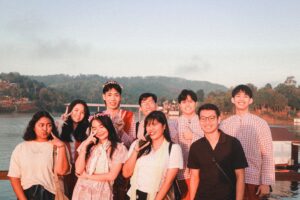
Farewell, but not Goodbye
Alas, students from all three learning journeys gathered in Kanchanaburi for one final hurrah – a farewell lunch set against the picturesque red and green hues of the nearby forest. All of us desperately tried to get photos with the many friends we made over the trip. Some exchanged hugs, a few shed a sentimental tear. It was clear that the Global Youth Camp succeeded in bringing peers hailing from diverse backgrounds together.
Summing up the indelible impression this trip made to her, a Year 1 CAPT student, Lim Qiao Yi, said, “Connecting with different people and the stories they possess unveiled lessons which cannot be found within the four walls of a classroom. Perhaps, true learning comes from appreciating the softer side to knowledge — knowledge of cultural empathy, creating friendships which knows no borders.”
